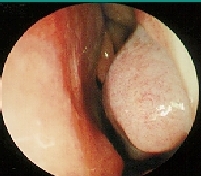(+) cheap/ OTC, SAFE (children & pregnant)
(-) difficult compliance (QID or before exposure)
(e.g.) cromolyn (Nasalcrom nasal spray), oloptamide (Patanol = eye drops; also has antihistaminic properties)
B) Decongestants can have side effects. They do not combat the allergic reaction, but rather mask the symptom of nasal congestion. Topical decongestants should not be used for longer than 5 days as the patient may develop rhinitis medicamentosa: an addiction to the spray; the nose is congested without it. These patients end up using the spray as often as 20x per day!
(+) mainly versus late phase allergic congestion, cheap/OTC or Rx combo
(-) insomnia, hypertension, anorexia, rhinitis medicamentosa
(*) topical or oral/systemic form
(e.g.) pseudoephedrine, phenylephrine, oxymetolazone; phenylpropanolamine (PPA) was removed from the market for risk of stroke
C) Corticosteroids are effective medications to treat allergies. There are many topical spays on the market; the sprays have similar effectiveness in patients, though in a test tube one may appear stronger than another. The medications can have some side effects, so they should be administered under a physician�s monitoring. Compliance is an issue with these medications; they need to be used daily as directed for maximal benefit. Unfortunately, squirting medications into one�s nose is not enjoyable, so many patients will use the medication as needed and hence, without full effect.
(+) partially reverse the allergic reaction (systemic: late, topical: both)
(-) bleeding, perforation, HPA suppression, growth suppression (mometasone and fluticasone shown to be safe in this respect), delay in effect
(*) variable efficacy in vitro yet equal efficacy in vivo (although, one study funded by Schering - makers of mometasone, showed fluticasone was more effective than mometasone)
(e.g.) beclomethasone (Beconase dry & AQ, Vancenase dry & AQ DS), flunisolide (Nasarel, Nasalide), budesonide (Rhinocort), fluticasone (Flonase), triamcinolone (Nasacort dry & AQ), mometasone (Nasonex)
D) Antihistamines are a mainstay in treatment for allergies. The first generation of antihistamines had considerable side effects. The second-generation antihistamines have much less side effects. These medications work systemically to stop the itching and rhinorrhea associated with allergies.
(+) predominantly control �wet� symptoms (rhinorrhea & sneeze: early phase)
(-) first gen: tachyphylaxis, sedation, anticholinergic
(e.g.) 1st gen: diphenhydramine, chlorpheniramine, tripolidine
2nd gen: loratidine (Alavert, Claritin, -d12, -d24), desloratidine (Clarinex), fexofenadine (Allegra, -D), cetirizine (Zyrtec)
topical: azelastine (Astelin), levocabastine (Livostin)
Loratidine is now available over the counter, whereas the other 2nd gen are still by prescription only.
My personal observations as to effectiveness: cetirizine> or =fexofenadine>>loratidine>placebo.
E) Other medications may be helpful in allergic rhinitis as well. Ask your physician.
Ipratropium bromide (Atrovent 0.03, 0.06%) can dry up nasal mucus; it is good for gustatory rhinitis.
Leukotriene inhibitors (e.g., montelukast (Singulair)) are useful with asthma. Singulair is newly approved for seasonal allergic rhinitis; it effectively reduces eosinophils which are associated with allergy and asthma.
Anti-IgE therapy has not been released yet, but it may prove to be a very powerful addition to our armamentarium for allergy/asthma.
